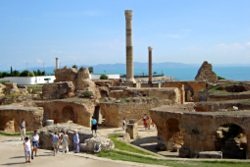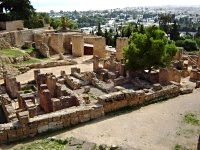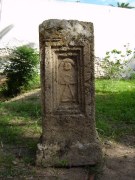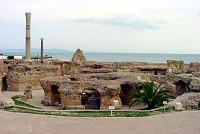 It is, indeed, an exceptional
experience to visit the site where in ancient times the mighty Carthage
was located. Only a few remains bear witness to this legendary
city which developed about 3000 years ago on the Gulf of Tunis from
a Phoenician colony. According to Dionyssios von Halikarnasos
the foundation dates back to 814 BC. It is, indeed, an exceptional
experience to visit the site where in ancient times the mighty Carthage
was located. Only a few remains bear witness to this legendary
city which developed about 3000 years ago on the Gulf of Tunis from
a Phoenician colony. According to Dionyssios von Halikarnasos
the foundation dates back to 814 BC.

The centre of the city was the
Byrsa Hill, the acropolis of Carthage as it is today. Southeast
of the hill a Punic residential area with multi-storey houses made
from mud brick on stone foundations was excavated. They
had courtyards, mosaic floors, swimming pools and underground cisterns
to collect water.
 The holiest site of Carthage
was the Trophet, a cemetery and ritual site. In the course
of excavations 12 layers of graves from the 8th cent B.C. up until
the early years of the Christian period were found as well as 1,500
steles with inscriptions and religious symbols. The excavations
revealed the remains of infants and children in large numbers which
suggests possible evidence of child sacrifices. The holiest site of Carthage
was the Trophet, a cemetery and ritual site. In the course
of excavations 12 layers of graves from the 8th cent B.C. up until
the early years of the Christian period were found as well as 1,500
steles with inscriptions and religious symbols. The excavations
revealed the remains of infants and children in large numbers which
suggests possible evidence of child sacrifices.
After its foundation the city developed into a flourishing commercial
centre and soon became one of the most important trading and sea
powers. In the 4th and 3rd centuries B.C. Carthage had become
the richest city in the Mediterranean area. The city had 400,000
inhabitants and a further 100,000 were living in the adjacent agricultural
areas. Their navy included some 300 to 350 warships!
Rivalry with Rome and Syracuse led to several wars. Best
known are the “Three Punic Wars”
(264 to 241 BC /218 to 201 BC /149 to 146 BC) between the
Carthaginian Empire and the expanding Roman Republic, which have
been among the most costly traditional battles of human history
and – Carthage lost them all!
The German writer Berthold Brecht once wrote: “The great
Carthage led three wars. It was still powerful after the first,
still inhabitable after the second. It was no more to be found
after the third”

The second Punic war became the most famous
due to Hannibal’s incredible crossing of the Alps with 37
war elephants, probably 50,000 infantrymen and 9000 cavalry.
However, in spite of crushing victories over Roman armies in Italy,
this war ended in Hannibal’s own country with a
heavy defeat at Zama, after which Carthage
lost its foreign sovereignty.
In the third Punic war, Carthage finally met its Waterloo.
It ended with the complete destruction of Carthage and the enslavement
of its inhabitants!
Roman period
 According
to a resolution by Julius Caesar in 46 BC the Emperor Augustus colonised
the place with 3000 people in 28 BC.. The city was now renamed “Colonia
Iulia Concordia Carthago” and rapidly developed into a flourishing
trading town again. Already, in the 2nd century Carthage,
with over 300,000 inhabitants, was the fourth largest city in the
Roman Empire after Rome, Alexandria and Antioch. It became
the centre of early Christianity in North Africa and due to its
size was, along with Rome, the most important Episcopal see in the
western half of the Roman Empire.. The most important remnants
of the Roman period in Carthage are the Antonninus Pius-Baths, According
to a resolution by Julius Caesar in 46 BC the Emperor Augustus colonised
the place with 3000 people in 28 BC.. The city was now renamed “Colonia
Iulia Concordia Carthago” and rapidly developed into a flourishing
trading town again. Already, in the 2nd century Carthage,
with over 300,000 inhabitants, was the fourth largest city in the
Roman Empire after Rome, Alexandria and Antioch. It became
the centre of early Christianity in North Africa and due to its
size was, along with Rome, the most important Episcopal see in the
western half of the Roman Empire.. The most important remnants
of the Roman period in Carthage are the Antonninus Pius-Baths,
The end of ancient Carthage.
In the course of Islamic expansion Arab troops under Hasan ibn
al-Nu’man defeated Carthage in the Battle of Carthage in 698
AD. It ended the reign of the Eastern Roman Empire.
Roman Carthage was destroyed just as the Romans had destroyed Carthage
in 146 BC.
Modern Carthage
Carthage
still is a popular tourist attraction and noble residential garden
suburb of Tunis, where also the Tunisian presidential palace is
located. On the Byrsa there is the largest church of North Africa,
the Cathedral of St. Louis, built in 1890, which was up to 1965
the Episcopal see of the archbishop of Carthage and is a cultural
centre today.
|